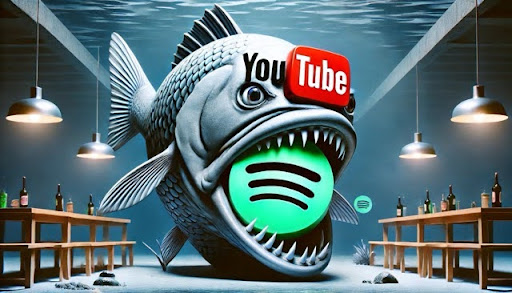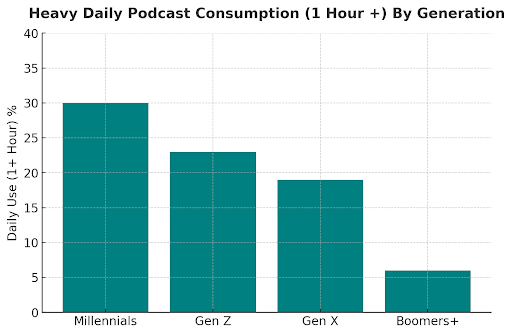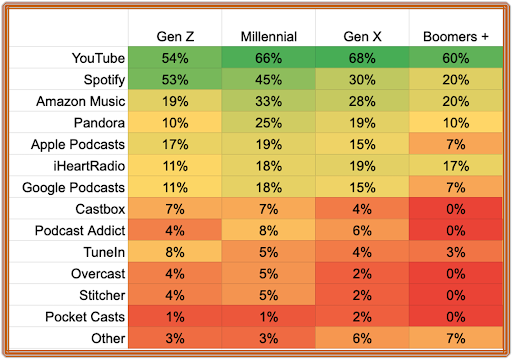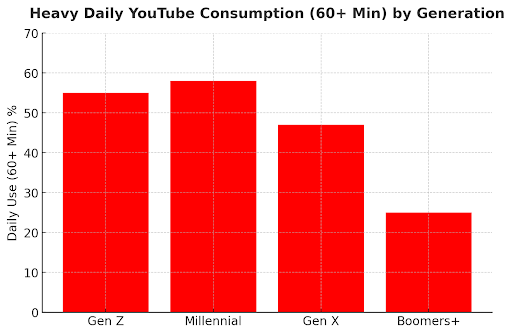Podcasts by Name, Video by Nature: Podcasts Aren’t Audio-First Anymore

For years, the word “podcast” has been synonymous with audio-first content—a passive listening experience consumed during commutes, workouts, and downtime. But that perception is no longer accurate. Podcasts have quietly become a video-first medium, and the numbers tell a striking story: YouTube is dominating podcast consumption, often outpacing traditional audio platforms. This shift is so significant that the very word “podcast” may be limiting creators, especially those who don’t fully embrace video.
Understanding the Data: The NuVoodoo Podcast Study
To fully grasp this shift, we conducted a comprehensive research project in Q1 2025 surveying 2,908 nationwide respondents above the age of 13 about their media habits. This included better than 1,200 weekly podcast listeners across all major generational segments. Our goal was to uncover how people consume podcasts today—how often, for how long, and most importantly, on which platforms. What we found was striking: podcasts are no longer an audio-first medium but instead a dominant force in the video space, primarily driven by YouTube.
Podcasts: A Vibrant and Growing Medium
Before diving into platform trends, it’s important to establish that podcast consumption is alive and well across all generations. Regular and heavy daily use shows strong engagement across age groups.
- Daily Podcast Consumption (30+ Min):
- Millennials lead the way at 43%.
- Gen Z follows at 37%.
- Gen X sees 29% engagement.
- Boomers+ still show 12% engagement, demonstrating at least some reach across generations.
Millennials outpace all generations for heavy daily podcast consumption (60+ Min) at 30%, far out-distancing even Zoomers (23%)

When broken down further into generational segments, Millennial Males (52%) and Gen Z Males (40%) are the top regular users, while Millennial Males (36%) also dominate heavy consumption. Gen Z Females (24%) and Gen Z Males (24%) are nearly equal in their 1+ hour daily use, highlighting strong engagement across young demographics.
YouTube is the #1 Podcast Platform
Looking at weekly podcast consumption, YouTube is the most widely used platform across all generational segments among podcast users, including Millennials, Gen Z, Gen X, and even Boomers. In fact, Gen X males (70%), Millennial males (67%), and Millennial females (65%) report using YouTube for podcasts more than any dedicated audio platform. Even among Boomers+, YouTube pulls in 61% of males and 52% of females.
Compare this to Spotify, the leading audio-only platform, where Gen Z females (54%) and males (53%) engage at high levels, but numbers drop significantly among older demographics. Apple Podcasts barely registers, with no generation cracking 25% weekly usage.
Which of the following platforms have you used to engage with podcasts in the past week? Check all that apply [Among podcast listeners, N=1219]

The clear takeaway? The podcast audience has already migrated to a video-first experience, even when consuming audio-driven content.
The “Podcast” Misnomer: How the Label Limits Growth
If people are primarily engaging with podcast content on screens via YouTube on mobile devices, smart TVs, or via connections like Chromecast, then the term “podcast” may be an outdated descriptor. Many consumers may not even identify their YouTube-based content consumption as “podcast listening,” even when it fits the traditional definition.
This hypothesis seems even more likely relevant if we consider massive heavy daily YouTube use levels, especially in the two youngest generations and in comparison to the heavy podcast use levels (60 Min+ Daily) displayed below.

This has two major implications:
- Underreported Audience Numbers: If traditional podcast audience measurement focuses on RSS-based distribution (Apple, Spotify, etc.), then the full reach of podcast content is vastly underestimated. YouTube’s integration into daily media habits means the real numbers could be much higher.
- Branding Liability for Podcasters: If audiences associate the term “podcast” with an audio-only experience, creators may be limiting their reach by sticking to outdated branding. Instead of “podcasts,” we may be moving into an era of “on-demand shows,” “streaming talk formats,” or even “interactive media.”
The Case for Rethinking Podcast Branding
Podcasts are no longer a niche category of downloadable audio files. They are a dominant media format integrated into video streaming habits, making them functionally closer to YouTube channels than to AM/FM radio.
If creators want to maximize their visibility and audience, they should consider:
- Prioritizing video production, even for discussion-based content.
- Reframing how they present their brand — “shows” or “episodes” instead of “podcasts.”
- Expanding discovery beyond RSS feeds, leveraging YouTube SEO, shorts, and video-first engagement tools.
The Evolution is Already Happening
This is not a theoretical shift—it’s already well underway. If the term “podcast” is starting to feel outdated, that’s because it is.
YouTube has made podcasting a visual experience, and platforms like Spotify and Apple are adapting to this reality by integrating video into their podcast strategies. The question for creators isn’t whether video should be part of their podcasting efforts—it’s whether they should keep calling it a podcast at all.
NuVoodoo conducts research and manages marketing campaigns for clients across a wide variety of industries. It’s easy to get in touch. Email tellmemore@nuvoodoo.com to learn how we can be your valuable partner.




